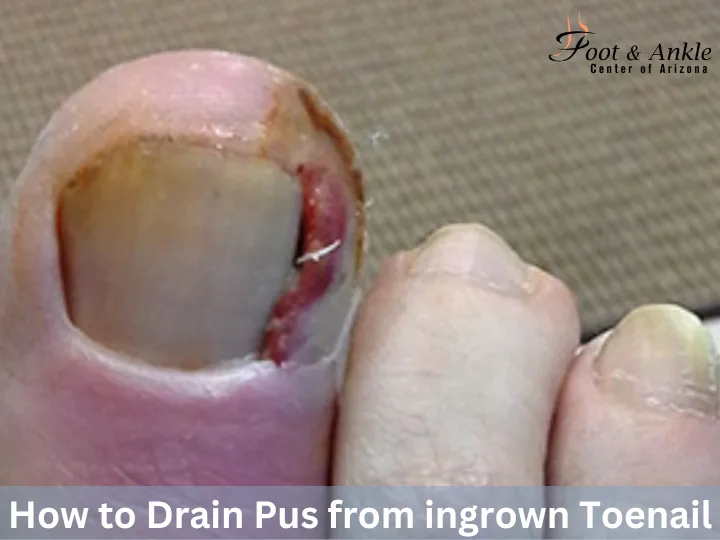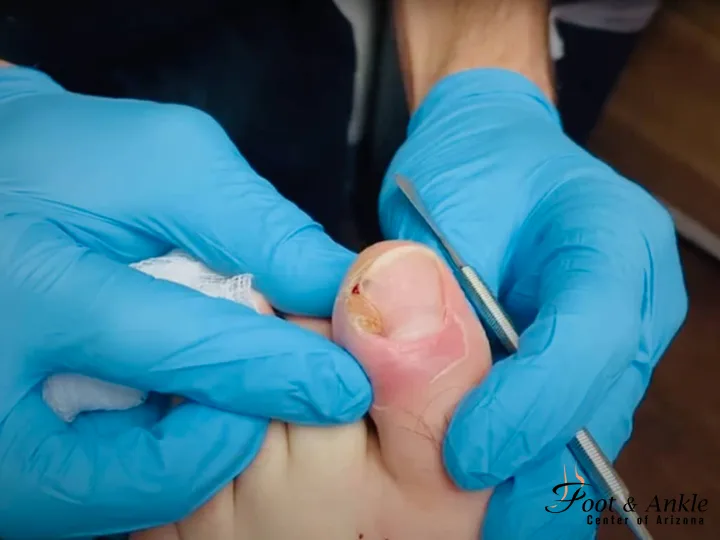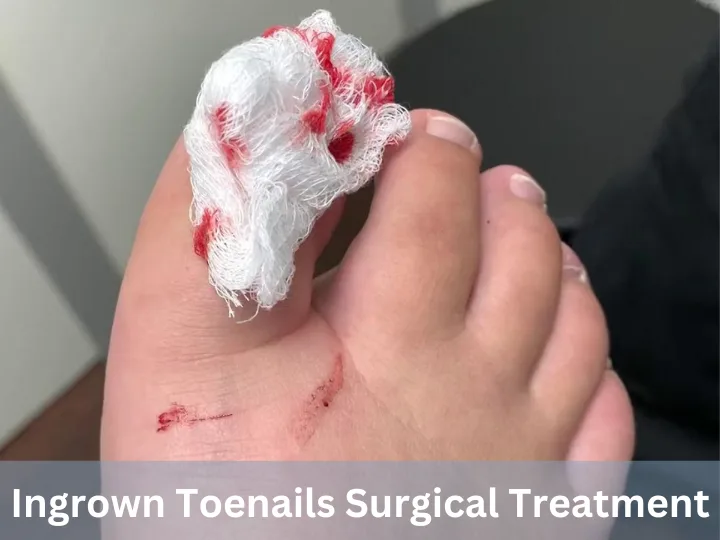Ingrown toenails can sometimes become infected and produce pus. If you searched for “How to Drain Pus From Ingrown Toenail,” it’s important to know that pus indicates an active infection that can worsen without proper care. While there are safe first-aid steps to reduce discomfort, attempting to drain pus at home can increase the risk of deeper infection or tissue damage.
At the Foot & Ankle Center of Arizona in Scottsdale, we provide clinician-performed drainage, appropriate antibiotic therapy, and minor procedures when needed to treat the infection safely and prevent recurrence.
Know About Ingrown Toenails
An ingrown toenail occurs when the edge or corner of the toenail grows into the flesh of the toe. This can cause redness, swelling, and pain. If the ingrown toenail breaks the skin, it can create an entry point for bacteria, leading to an infection. Symptoms of an infected ingrown toenail include increased redness, swelling, throbbing pain, and the presence of pus.
Recognizing the Signs of Infection
Before attempting to drain pus from an ingrown toenail, it’s crucial to recognize the signs of infection. An infected ingrown toenail often exhibits:
- Redness and swelling: The skin around the ingrown toenail becomes red and swollen.
- Pain: Throbbing or sharp pain around the affected area.
- Pus: Yellow or greenish fluid may be visible, indicating an infection.
- Warmth: The area may feel warm to the touch, a sign of inflammation.
- Odor: An unpleasant smell may emanate from the toe, suggesting bacterial growth.
If you notice these symptoms, it’s essential to address the infection promptly to avoid complications such as cellulitis or abscess formation.
How to Drain Pus from an Ingrown Toenail
Step 1: Gather Supplies
Before you begin, gather the necessary supplies to ensure the process is sterile and effective:
- Warm water
- Epsom salt
- Antibacterial soap
- Clean towels
- Sterile gauze or cotton balls
- Tweezers and nail clippers (sterilized)
- Antibiotic ointment
- Adhesive bandage
Step 2: Soak the Foot
Start by using soaking the affected foot in warm water mixed with Epsom salt. This allows to soften the skin and nails, making the technique much less painful and greater effective. Soak your foot for 15-20 minutes, 3 to four instances an afternoon. Epsom salt also has antibacterial houses that can help lessen the infection.
Step 3: Clean the Area
After soaking, clean the affected area with antibacterial soap to remove any dirt and bacteria. Pat the foot dry with a clean towel. Ensuring the area is clean reduces the risk of spreading the infection further.
Step 4: Sterilize Your Tools
Before trying to drain the pus, sterilize your tweezers and nail clippers. You can do this by using boiling them in water for a few minutes or wiping them down with rubbing alcohol. Sterilization is critical to save you the introduction of greater bacteria into the infected region.
Step 5: Gently Lift the Nail
Using the sterilized tweezers, lightly raise the corner of the ingrown nail faraway from the pores and skin. This can be painful, so proceed with caution. The purpose is to create a small space in which the pus may be tired. Do now not pressure the nail if it’s miles too painful or deeply embedded; are searching for expert scientific help in such instances.
Step 6: Drain the Pus
Once you have a small gap, gently press on the sides of the toenail to encourage the pus to drain out. Use sterile gauze or cotton balls to wipe away the pus. Be careful not to push too hard, as this can cause further damage and pain. If the pus does not drain easily, do not continue to press. Instead, consider seeing a healthcare professional for further assistance.
Step 7: Apply Antibiotic Ointment
After draining the pus, apply a thin layer of antibiotic ointment to the area. This helps prevent the infection from spreading and promotes healing. Cover the toe with a sterile adhesive bandage to keep it clean and protected.
Step 8: Monitor and Care
Keep an eye on the affected toe over the next few days. Continue soaking the foot in warm water and Epsom salt, and reapply antibiotic ointment and a fresh bandage daily. If the infection does not improve or if you notice increased redness, swelling, or pain, seek medical attention immediately.
What Causes Ingrown Toenails?
Medically, ingrown toenails are referred to as onychogryphosis. The irritation occurs when the edge or corner of a toenail grows into the surrounding skin. Ingrown toenails often result from poor nail-cutting techniques, wearing tight footwear, and/or injury to the toenail. Genetic factors can contribute as well in the form of naturally curved toenails.
Toenail Infection Symptoms
An untreated ingrown toenail can lead to infection, presenting symptoms such as:
- Redness and swelling: The affected area becomes inflamed.
- Throbbing pain: Persistent pain which worsens with pressure.
- The formation of pus: Yellow or greenish discharge around the nail.
- Heat and odor: The area might be warm to the touch and produce a foul smell due to bacterial proliferation.
If these symptoms are present, addressing the infection promptly is crucial to avoid further complications.
How Are Ingrown Toenails Diagnosed?
Diagnosis often consists of a doctor examining the toe physically. Redness, swelling, and pus are symptoms that indicate it quite clearly. For recurring cases, your doctor will have to examine any prevailing conditions, like diabetes or vascular problems, which may be exacerbating the condition further.
Ingrown Toenails Home Treatment
Home care, in cases that are light, involves the following steps:
- Soak the Foot: Soak the foot in warm water mixed with Epsom salt to soften the skin and reduce inflammation.
- Keep it Clean: This is with antibacterial soap, drying the area with a towel.
- Elevate the Nail: Gently lift the nail using sterilized tools to reduce pressure on the skin.
- Apply Antibiotics: Apply antibiotic ointments to avoid further infection.
- Monitor for Changes: Keep track of worsening symptoms and consult a professional if needed.
A. Why Home Drainage Is Not Recommended (short paragraph)
Draining pus at home with unsterilized tools may push bacteria deeper, cause tissue damage, and increase the chance of complications such as cellulitis or systemic infection. Patients with diabetes, poor circulation, or immune suppression are particularly at risk and should never attempt home drainage.
B. Safe First-Aid Steps Before You See a Doctor (bulleted)
- Soak the foot 10–15 minutes in warm water to ease pain and reduce swelling.
- Gently pat dry and cover with a clean sterile dressing.
- Apply a topical antibiotic ointment lightly and change the dressing daily.
- Avoid cutting, digging, or forcibly lifting the nail.
- Seek medical care same day if pus persists, redness spreads, or you develop fever.
Ingrown Toenails Surgical Treatment
For severe or recurring cases, surgical options include:
- Partial Nail Removal: Removes the ingrown section of the nail and is usually performed with a procedure to prevent regrowth.
- Total Nail Removal: This is where the entire nail is removed.
- Orthonyxia: A corrective treatment using braces or splints to reshape the nail.
After Treatment: Caring for Your Toe
Proper care after treatment of an ingrown toenail is required for its healing and prevention of recurrence. Here’s what you need to do:
- Keep the Area Clean: Wash the toe daily with mild soap and water. Pat it dry with a clean towel.
- Apply Medication: Apply any prescribed antibiotic ointment or cream to prevent infection.
- Change Dressings Regularly: Replace bandages daily or as directed by your healthcare provider to maintain sterility.
- Avoid Pressure: Conserve the irritation for the treated toe with open-toed or roomier footwear.
- Look for Signs and Symptoms of Infection: Include redness, swelling, or pus. If any of these are present, make sure to call your doctor immediately.
- Follow-up Appointments: The doctor may schedule one or more follow-up visits to check that the toe is properly healing.
Long-Term Prevention Tips
To keep your toenails healthy after treatment:
- Trim toenails straight across to prevent future ingrowth.
- Wear comfortable shoes allowing your toes ample room.
- Keep the feet clean and warm: wash and dry the feet thoroughly.
- Avoid activities that may hurt your toes while recovering.
When to Seek Professional Help
While draining pus from an ingrown toenail can be done at home, certain situations warrant professional medical intervention:
- Severe Pain: If the pain is intense and unmanageable, seek professional help.
- Deep Infection: If the infection appears to be deep or spreading beyond the toe.
- Underlying Health Conditions: Individuals with diabetes, poor circulation, or weakened immune systems should consult a doctor before attempting to drain pus at home.
- Persistent Symptoms: If symptoms do not improve within a few days of home treatment, it’s crucial to seek medical attention.
Preventing Ingrown Toenails
Preventing ingrown toenails is better than treating them. Here are some recommendations that will help you keep away from this painful situation:
- Proper Nail Trimming: Cut your toenails straight across and avoid rounding the edges. Use clean, sharp nail clippers.
- Wear Proper Footwear: Choose shoes that fit well and provide enough room for your toes. Avoid tight shoes that squeeze the toes together.
- Maintain Foot Hygiene: Keep your feet clean and dry. Wash them regularly and dry them thoroughly, especially between the toes.
- Avoid Trauma: Protect your toes from injury by wearing protective footwear when necessary.
- Regular Foot Checks: Inspect your feet regularly for signs of ingrown toenails or other issues, especially if you have diabetes or other conditions that affect foot health.
Professional Treatment Options
At the Foot and Ankle Center of Arizona, Dr. Kris A. DiNucci and our team offer several professional treatments for ingrown toenails, especially for cases that are recurrent or severe:
- Partial Nail Removal: In this procedure, only the ingrown part of the nail is removed. This is often accompanied by a procedure to prevent that part of the nail from growing back.
- Total Nail Removal: In severe cases, the entire toenail may be removed. This is usually a last resort and may be necessary if the nail is severely infected or deformed.
- Antibiotics: If the infection is severe, oral or topical antibiotics may be prescribed to help clear it up.
- Orthonyxia: This involves using a small brace or splint to help straighten the nail and prevent it from growing into the skin.
Conclusion
Ingrown toenails are a common and painful trouble, but with right care and attention, you could manipulate and deal with them successfully. Knowing the way to drain pus from an ingrown toenail can offer relief and prevent similarly complications, however it’s crucial to continue with caution and are trying to find expert help while wished. At the Foot and Ankle Center of Arizona, Dr. Kris A. DiNucci and our team are committed to offering expert care for all of your foot and ankle wishes. Don’t hesitate to reach out for expert treatment in case you’re handling a cussed or intense ingrown toenail.
For more information or to agenda an appointment, touch the Foot and Ankle Center of Arizona these days. Your foot fitness is our priority, and we’re here that will help you stroll easily and optimistically.






